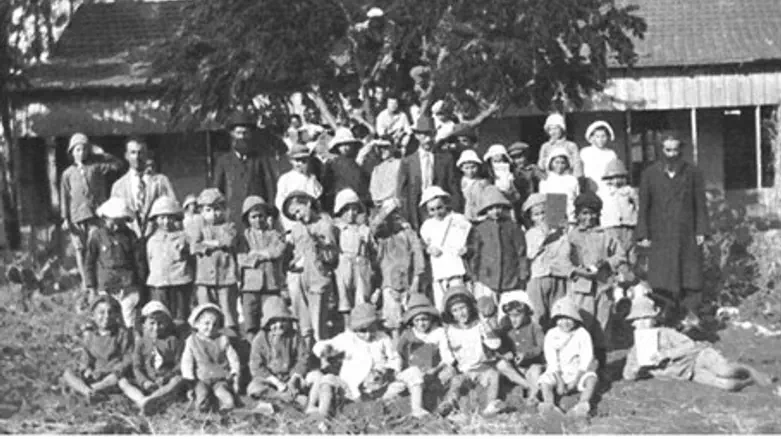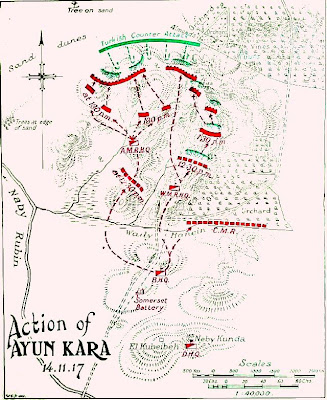
To the right, a school house in Rishon LeZion with students and teachers. The picture was taken by Trooper Charles Thomas Broomfield of the New Zealand Mounted Rifles after the November 14, 1917 battle of Ayun Kara and the liberation of Rishon LeZion. Rishon was founded on July 31, 1882 by Russian Jews who had purchased 835 acres from the Arab village of Ayn Kara.
One of the most unusual collections I came across recently are the photos taken by a New Zealand Jewish soldier, Charles Thomas Broomfield, of the New Zealand Mounted Rifles. The photos were donated by his granddaughter Judy Cato to the NZMR Association. She provided the following biography:
Trooper Broomfield (1917) in colorized
photograph
Charles embarked from New Zealand on 31st May 1917 aboard the Union Steamship Moeraki. He was one of 262 New Zealand service men headed for Suez, Egypt. The Regiments transhipped at Sydney onto the Port Lincoln.They arrived at the Port of Suez on the 6th August after a stopover in Colombo, India.
The New Zealand Mounted Rifles provides this history of the battle of Ayun Kara and the special relationship that developed between Broomfield's unit and the Jewish community of Rishon LeZion and recorded in Broomfield's camera:
The Synagogue of Rishon LeZion, presumably
with Broomfield standing at the left.
Another picture of the children of Rishon LeZion. The boy
in the foreground appears in the third of row of the
schoolhouse picture above
Photo: NZMR troopers and people of Rishon LeZion turn out for a
memorial service on the first anniversary for the New Zealand
soldiers who died at the nearby battle of Ayun Kara. "A short
time after this service, the men's bodies were re-interned at
the Ramleh Cemetery. The memorial site of Ayun Kara
was forgotten and years later no one was sure of where
the actual site had been, the memorial obelisk had
disappeared. Destroyed by whom and when, nobody knows."
Since crossing the arid Sinai Desert and its confrontation with a hostile Turkish enemy and, more often than not, a treacherous contact with Arab Bedu tribesmen - The Auckland Mounted Rifles agreed it was a joy to meet a people who had just been freed from Turkish tyranny. It was a land worked into agriculture and planted with fruit trees and vineyards. Not only were the men taken with the settlement conditions, the horses too were impressed and ate heartily of green feed, and enjoyed the soil firm under foot.
A few weeks later the Regiment remembered the village, the official history "Two Campaigns" reported: "On January 12, the brigade moved north to Rishon LeZion, the Jewish village near to Ayun Kara, and there tents were provided, and training and football again became the normal life."
Map of the Turkish and New Zealander positions is above. The NZMR history notes, "The date 14th November 1917 is the greatest day of action carried out by the Mounteds. The attack on the strongly fortified Turkish trenches near the town of Rishon LeZion in present day Israel is a story of guile, courage and great daring against a superior force."
Additional information on the battle of Ayun Kara can be found here:
"The Action at Ayun Kara on the 14th November 1917 was carried out by the New Zealand Mounted Rifles on heavily entrenched Turkish defences. This successful rout of the enemy is remembered for its daring frontal rush by mounted troops and tactical movements in support by the brigades riflemen and machine gunners."
The following is a school essay describing the battle written by a boy from Rishon, Aviram Hochberg, in 1918. He assumed the New Zealanders were "English" soldiers: :
From Broomfield's album. Are these children of Rishon
LeZion on their way to the memorial service?
Rishon residents on the way to the memorial service? Another picture
from the Broomfield album.
The next morning some of our village we went the field of death to collect the wounded. What a terrible scene it was! The mountains that were always covered with green grass and beautiful flowers, where shepherds were herding their sheep, were now covered with the dead, wounded and blood here and there. Dead Horses, rifles lying on the ground and crater everywhere from the shells. Smell of gun powder and dynamite everywhere. The wounded were collected and we shall send them on the camels of the English to the hospital that was [opened] in Rishon."






